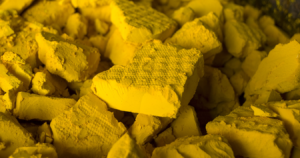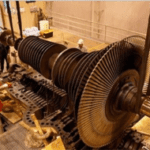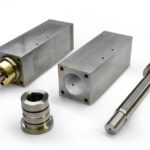In the past, routine maintenance on the General Electric (GE) 7FA-class gas turbine coupling was time-consuming, costly, and presented unnecessary safety risks for service technicians and plant maintenance crews. Now, there’s an alternative that improves the disassembly and reassembly process during planned outage maintenance and when unplanned repairs are required.
Chris Stocker boarded a plane in early March. The destination: Dallas, Texas. His mission: To test a new tool at a 300-MW combined cycle power plant. The goal: To prove that the device could reduce the time it takes to disassemble and reassemble a turbine coupling from a total of as long as 20 hours to just 4 hours—an 80% time-savings per turbine.
Stocker is a product account manager for Power Generation with Enerpac. For the past two years, Enerpac engineers Robert Karol and Jon Slocum have been working in close collaboration with power plant service organizations to develop the tool, which is designed to make it safer and easier to perform routine maintenance or unplanned repairs on GE 7FA-class gas turbines. The project began when the team recognized that the current method for performing this task was overly laborious and fraught with risk.
Existing Maintenance Process and Problems
When gas turbines reach certain milestones based on runtimes or startups, original equipment manufacturers (OEMs) recommend they be taken offline for maintenance. During these maintenance outages, a turbine can be out of service for a month or more in some cases. That’s because not only is there a long list of time-consuming tasks, there are also some critical-path steps that cannot be changed. This means that not all work can happen simultaneously. Maintenance goes smoother when there is more predictability on the length of time critical-path jobs will take so that technicians know when other tasks can commence.
There are several problems with the current tooling method for coupling bolt tensioning. Imagine this: Your job is to carefully de-tension and then tension coupling bolts that connect the main turbine shaft to the generator. Each bolt is made of high-grade alloy steel, which is very expensive to replace. In fact, if any one bolt is damaged during maintenance, a matched replacement set must be ordered from the OEM.
The reason something might go wrong is because the current tool available on the market to perform this job weighs more than 110 pounds. The heavy weight often causes fatigue and increases the likelihood of trouble. The tool also requires a lot of manual input and manipulation. Having a tool that is very hands-on and difficult to use brings added risk to a job that is already inherently dangerous. The level of confidence technicians have when using the tooling is typically quite low, and it makes for a time-consuming job. Both the de-tensioning and tensioning processes can take eight to 10 hours each. After hearing gripes from users in the field, Enerpac knew there had to be a better way.
The new tool, called the Enerpac Enhanced Turbine Coupling Tool (or ETCT) passed its trial test in the spring with flying colors. It reduced the manpower to de-tension a unit down to less than two hours, a job that would have normally taken a full 8- to 10-hour shift. Plus, the tool allows the technicians to remain hands off and safely away from any danger during the process. Furthermore, the built-in braking system keeps safety at the forefront should any unforeseen instances occur during operation. Customers have been asking Enerpac to create a tool that is safer and easier to use, and now it’s here.
Safety. The design of the tensioner that Karol and Slocum developed is built from decades of experience in hydraulic tooling design and manufacturing. The engineers knew how to select the right material and design a suitable seal that would work well for regular scheduled maintenance. With proper training, technicians can have peace of mind during use.
The use of a mandrel for each stud improves engagement and lessens the wear and tear on tapered threads. The mandrel is installed by hand, not while holding a very heavy tool in extremely awkward and dangerous positions.
The carousel carries the two tensioning tools for the full evolution of the process. The technicians only need to mount it once and the work is performed with a weightless, balanced system that technicians just rotate from set to set and slide in and out (Figure 1). This allows the technicians to remain hands-off and safely away from the tooling during the pressuring-up step in the process. The carriage brakes control the tools while under high pressure and have been developed to arrest the tooling during any bolt or thread failure. The brake on the carousel also helps control the carousel during tool loading. Both systems keep the technicians safe, as well as prevent damage to the coupling, tooling, and carousel.
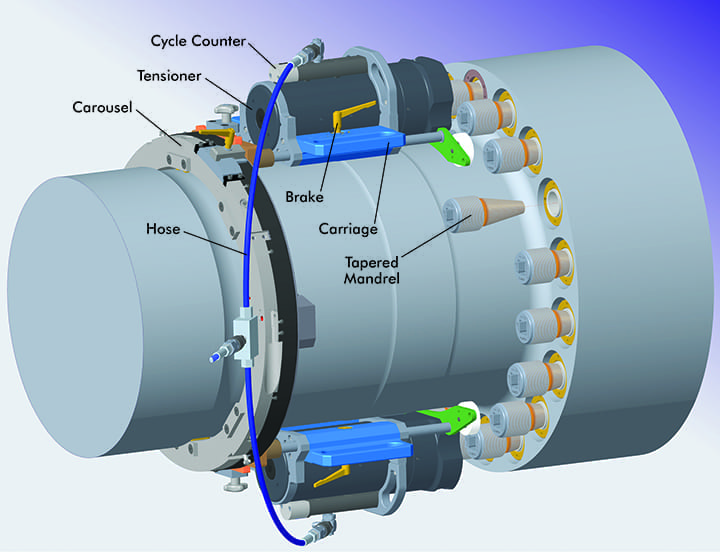 |
|
1. The Enhanced Turbine Coupling Tool (ETCT) has been designed and tested to specifically address the tensioning challenges that many power plants struggle with during gas turbine coupling maintenance. Courtesy: Enerpac |
Manpower Savings. A safe and easy-to-use system allows maximum speed to be reached easily. During initial testing, two Enerpac engineers performed the tightening process on three couplings in approximately eight hours. The last coupling took only one hour to complete before it was ready for measurement. Elongation measurements were all within spec and no trim passes were needed on the last two couplings. This was a marked time savings improvement over the previously used process. It is expected that times will decrease further as workers gain familiarity with the setup process.
Improved Tooling
The setup of the ETCT involves a three-step process: install mandrels, mount carousel, and load tensioners.
Mandrels. The included mandrels allow technicians to install the mandrel accurately into the tapered thread of the stud by hand, without the weight of the attached tooling. Each mandrel has a 1-inch square drive in the end, which allows installing and removing with a wrench, if needed. This approach allows Enerpac to make a positive tapered-thread engagement, torque each mandrel to a specific value, and eliminate the use of “tribal knowledge” to manage the process.
An example of tribal knowledge that has been witnessed in the field is the suggestion to “tighten, then loosen” the current tooling’s puller bar. The reasoning behind the advice is that tensioning load tends to “lock” the two tapers together, which makes loosening quite difficult. To remedy this, technicians will often incorrectly tighten the puller bar and then turn it back (loosening) between 30 and 45 degrees. The reverse rotation of the puller bar causes it to disengage by about 25% and has been identified as the root cause of many thread failures and stuck studs.
Carousel. The carousel that supports the tools during the loosening/tightening process offers the end-user many benefits. First, it mounts the tooling to a fixed point that allows full, effortless, 360-degree rotation. This makes the tool “weightless” to the operators and improves safety immensely. Mounting chain hoists and straps to aid in moving around the coupling and positioning the current tooling onto the studs is no longer necessary.
The ETCT has a split-frame bearing carousel design that comes as two pieces for an easy installation. The system is fully balanced with one tool on each side of the coupling to allow for total control of the tooling and balanced maneuverability. The carousel is set to the specific bolt circle for each side of the coupling—turbine or generator. The tensioners slide in/out on a carriage to engage/disengage with the mandrel, which has a normal American National Standards Institute Unified National Course (ANSI UNC) thread form, and is easy to operate. The carriage also includes an energy-absorbing braking system to control the tooling from moving away from the flange in case of a failed thread. The tapered thread condition can be an unknown and Enerpac has made the tooling as safe as possible by controlling the forces involved.
Tensioners. The tensioning tools have been specifically designed for this application (Figure 2). They include spring return for fast piston return, a pin socket to turn each nut with 12 holes for easy access and speed of loosening/tightening the coupling nut, and a puller bar designed to engage with a custom mandrel interface. A cycle counter tracks the number of cycles each tool has been used to allow timely maintenance.
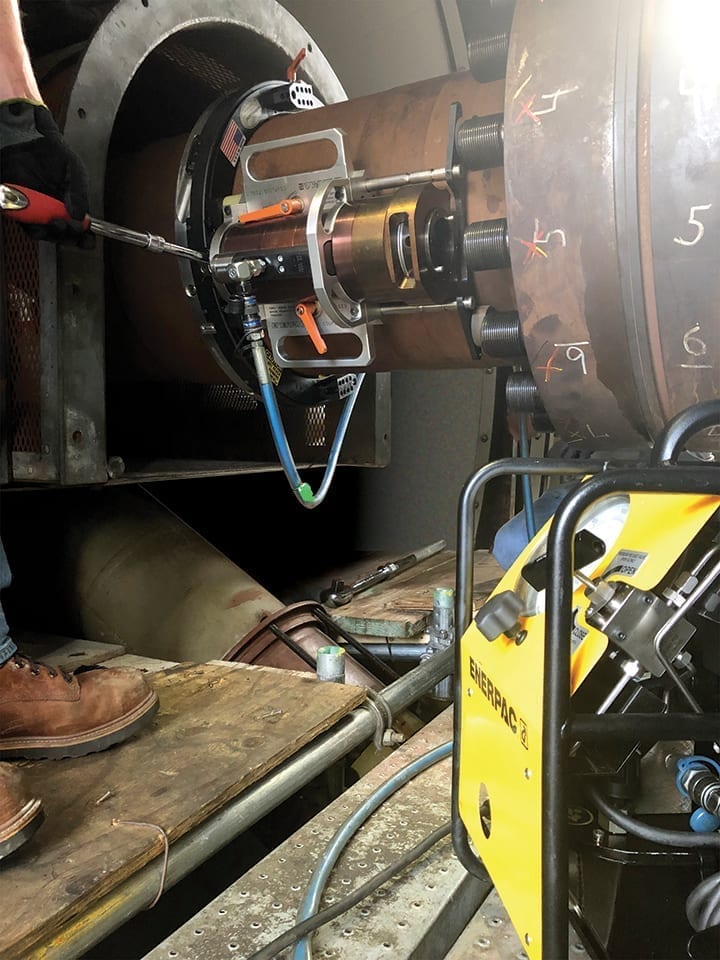 |
|
2. This image shows a prototype field trial of the ETCT. Testing has proven that the tool can decrease the time required to de-tension and tension GE 7FA-class gas turbine coupling bolts by 80%, while making the job easier and improving safety. Courtesy: Enerpac |
The design is a triple-deck tensioner (three separate rams) to keep the outer diameter (OD) as small as possible. This allowed Enerpac to design the tool with the optimal cylinder wall thickness to control the hoop-stress, along with a seal cross section for extended life and minimal maintenance. Enerpac offers a five-year warranty on the seals (tested to 10 years of use) to provide quality assurance for users. Each ETCT kit has two tensioners included to provide balance on the carousel and reduce time, allowing technicians to loosen/tighten two studs at a time.
The tensioning pump included in the kit is an Enerpac 21,750-psi pump that operates on a 110-V extension cord. The major benefit of this pump is the remote control, allowing just two technicians to perform the tensioning and run the pump. The remote feature places full control in the hands of the technicians while they observe the tooling as the pressurization/tensioning is performed. The pump will hold at full pressure and then allow release of the pressure to begin the loosening process from the current studs to move to the next studs in the set. The technicians can stay back from the tooling and keep their eyes on the job as all work is performed.
High Demand. Earlier this summer, Enerpac engineers and product managers unveiled the new tool at the 7FA Users Group Digital Conference to a virtual audience of more than 250 people. Coming out of the conference, the team received nearly a dozen inquiries from attendees who wanted to obtain the tool for their fall maintenance outages. The positive response from plant personnel reinforces Enerpac’s belief that maintenance will go faster and smoother than ever thanks to the new tool, which saves time and money without sacrificing safety.
—Jim McTaggart is president of Enerpac Americas.



